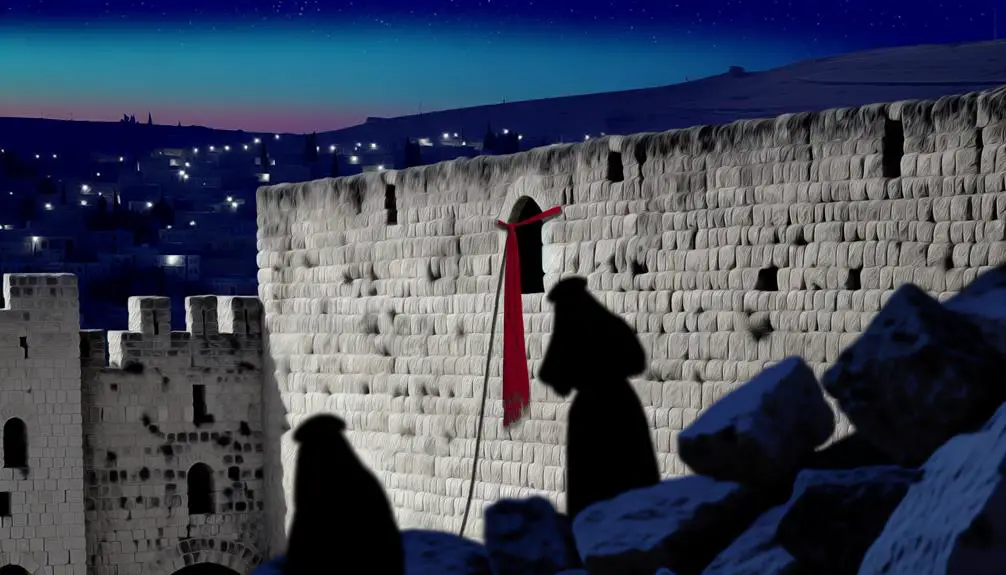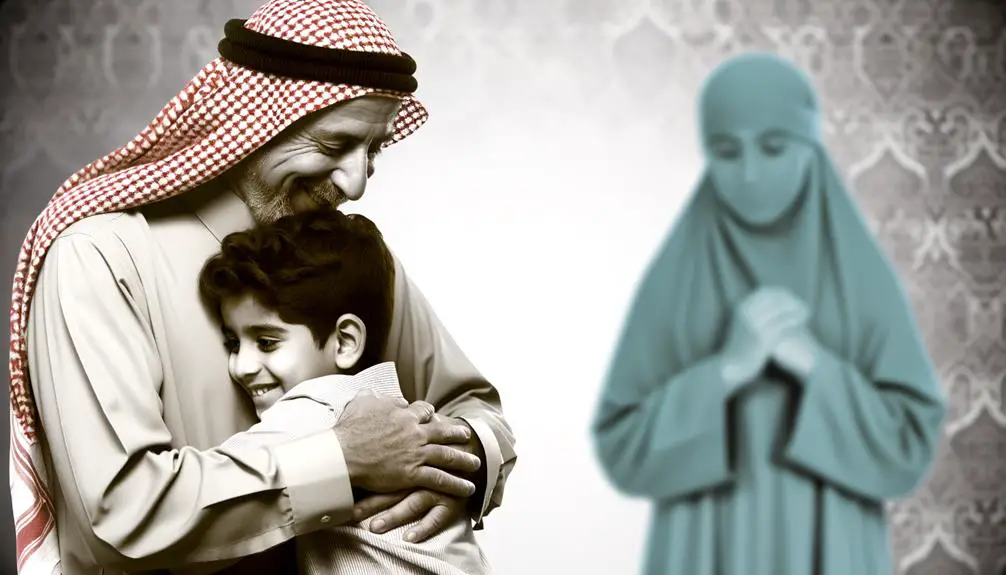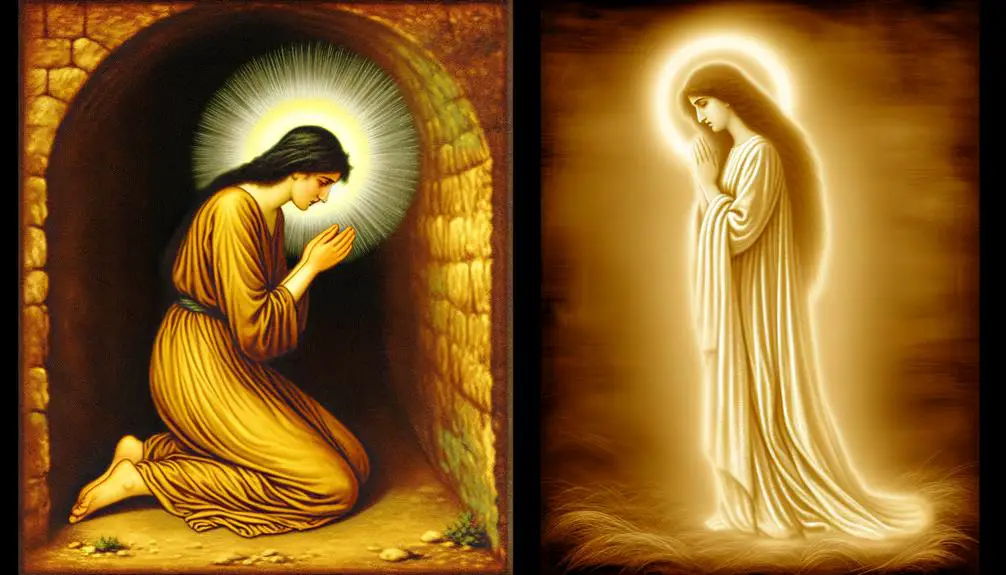From Rahab to Mary Magdalene, explore how harlots in the Bible reveal unexpected lessons in faith and redemption.

Harlot in the Bible
Let's fast-forward through history and land in a time where the term 'harlot' frequently pops up in biblical narratives. You'll find that these stories aren't just ancient gossip; they're layered with themes of redemption, forgiveness, and the complexities of human morality.
Consider Rahab, who, despite her profession, plays a crucial role in the story of Jericho. Her tale, alongside others like Mary Magdalene and the allegory of the Great Harlot, offers a deeper understanding of faith and transformation.
So, why should you keep exploring these narratives? They challenge us to look beyond the surface and question our perceptions of sin and virtue.
Key Takeaways
- The term "harlot" in biblical narratives often symbolizes moral decay and the need for spiritual renewal.
- Figures like Rahab highlight the possibility of redemption and transformation from sin through faith and loyalty.
- The allegory of the Great Harlot warns against false religions and underscores the importance of discernment in spiritual beliefs.
- Feminist perspectives challenge historical mischaracterizations of women labeled as harlots, promoting a reevaluation of their roles in religious history.
Rahab's Story of Redemption

Rahab's transformation from a harlot to a pivotal figure in the biblical narrative exemplifies a profound story of redemption and faith. Her journey, intricately woven into the fall of Jericho's walls, serves as a testament to the unexpected ways in which redemption can manifest. You'll find that her actions, particularly her decision to shelter Israelite spies, mark a significant pivot not only in her life but also in the broader context of the Israelites' conquest of Canaan.
Analyzing Rahab's narrative requires an understanding of her initial position within Jericho's societal structure. As a harlot, her social standing was marginalized, yet her profession provided her with unique access to information and individuals passing through the city. This strategic advantage positioned Rahab as a key asset when she chose to hide the spies sent by Joshua to assess Jericho's defenses.
Rahab's request for protection for herself and her family, in exchange for her service to the spies, underscores a mutual recognition of faith and loyalty. Her acknowledgment of Yahweh's power and her proactive steps to align herself with His people highlight a remarkable shift in allegiance, driven by her newfound faith.
The fall of Jericho's walls, precipitated by Rahab's assistance, symbolizes not just the physical but also the spiritual barriers that were overcome through her act of faith. By providing the spies' shelter, Rahab not only secured her own redemption but also facilitated a pivotal victory for the Israelites. Her story emerges as a powerful narrative of faith, redemption, and the transformative power of taking a stand, regardless of one's past.
The Parable of the Prodigal Son

Shifting our focus from the Old Testament to the New, we encounter another profound narrative of redemption in the Parable of the Prodigal Son. This story, found in the Gospel of Luke, illustrates the themes of mercy and forgiveness through the lens of family dynamics and an inheritance dispute. It serves as a rich text for analysis, particularly in understanding the complexities of human nature and divine grace.
The parable unfolds as follows:
- The Request and Departure: A younger son demands his share of the inheritance from his father, which is granted. He squanders this wealth in a distant land, leading to his destitution. This act not only signifies a break from familial bonds but also highlights the impulsive nature of youth and the consequences of such rash decisions.
- The Return: In his misery, the son decides to return to his father, expecting to be treated no better than a hired servant. His father, however, welcomes him back with open arms, celebrating his return with great fanfare. This moment encapsulates the essence of forgiveness and unconditional love, challenging societal norms surrounding honor and shame.
- The Elder Son's Resentment: The elder son's reaction to his brother's return and their father's joyous reception brings to light another facet of family dynamics—the feeling of injustice and neglect that can emerge in the face of perceived preferential treatment. This subplot further complicates the narrative, adding layers to the theme of redemption.
Analyzing the Parable of the Prodigal Son reveals insights into human behavior, divine forgiveness, and the intricate relationships within a family. It serves as a timeless reflection on repentance, love, and reconciliation.
Mary Magdalene: From Sinner to Saint

Delving into the transformation of Mary Magdalene, we encounter a narrative that transitions her from a figure of sin to a saintly icon, illustrating the profound capacity for redemption and change within the Christian tradition. This metamorphosis, deeply embedded in theological and cultural discourses, reflects not only a personal journey of transformation but also highlights the broader dynamics of forgiveness and sanctification in Christian theology.
The portrayal of Mary Magdalene as a penitent sinner, often conflated with being a harlot, is riddled with historical inaccuracies. Scholarly analysis indicates that this depiction stems more from later interpretations and ecclesiastical traditions than from the canonical texts themselves. The Gospels, in their essence, present Mary Magdalene as a devoted follower of Jesus, one of the first witnesses to His resurrection, without any explicit reference to her as a sinner of sexual immorality.
Feminist perspectives have critically engaged with the narrative surrounding Mary Magdalene, challenging the patriarchal constructions that have historically marginalized her role. These interpretations seek to reclaim her significance, not as a redeemed sinner, but as a pivotal figure in the early Christian movement. They argue that the mischaracterization of Mary Magdalene has perpetuated stereotypes that diminish women's contributions and leadership within religious contexts.
In examining the transformation of Mary Magdalene's narrative from sinner to saint, it becomes evident that the story is as much about the reinterpretation and reclamation of her identity as it's about the enduring themes of redemption and grace within Christianity. This reevaluation not only corrects historical inaccuracies but also aligns with feminist efforts to acknowledge and celebrate the roles of women in religious history.
The Allegory of the Great Harlot

The allegory of the Great Harlot, found in the Book of Revelation, serves as a complex symbol of corruption and idolatry, challenging readers to discern its implications within a broader theological and moral framework. This imagery isn't just a narrative device but a profound exploration of the spiritual decay and moral compromise that can infiltrate societies and individuals alike.
Through a symbolic interpretation, you're invited to peel back the layers of this allegory, revealing not just religious but also political implications.
- Symbolic Interpretation: The Great Harlot is often interpreted as a representation of false religions, systems, or entities that lead people away from divine truth. This symbolism encourages you to consider the various ways in which corruption and idolatry manifest in the world, urging a reflection on personal and collective adherence to genuine values and beliefs.
- Political Implications: The allegory also carries significant political undertones, depicting the harlot as being in league with kings and merchants, symbolizing the corrupt alliances between political power and religious or ideological falsehoods. This aspect challenges you to critically analyze the intersections between power, morality, and spirituality in governance and societal structures.
- Call to Discernment: Ultimately, the allegory serves as a call to discernment, encouraging a vigilant examination of one's surroundings and the influences that shape beliefs and actions. It prompts a deep consideration of what it means to remain faithful in a world rife with moral compromises.
Through this analytical lens, the allegory of the Great Harlot transcends its ancient context, offering timeless insights into the dynamics of corruption, idolatry, and the quest for integrity.
Lessons in Forgiveness and Faith

Exploring the theme of the Great Harlot further, we find that lessons in forgiveness and faith emerge as central to understanding its broader implications for spiritual growth and renewal. The narrative offers a profound exploration of divine mercy and transformative repentance, challenging you to consider the depth and breadth of forgiveness.
The accounts of the Harlot are not merely historical or metaphorical anecdotes but are imbued with lessons that resonate with contemporary struggles of faith and morality. Through these stories, you're invited to reflect on the power of divine mercy—an unearned grace that prompts transformative repentance and fosters spiritual rebirth.
Theme |
Implication |
Application |
|---|---|---|
Divine Mercy |
Unconditional love and forgiveness |
Embrace grace; forgive others |
Transformative Repentance |
Change of heart leading to renewed life |
Seek genuine change |
Faith Renewal |
Strengthened belief after forgiveness |
Rekindle faith through trust |
Spiritual Growth |
Development through trials |
Learn from past mistakes |
Moral Reflection |
Consideration of personal ethics |
Evaluate and adjust behavior |
This table illustrates the intricate relationship between divine mercy, transformative repentance, and their subsequent impact on faith renewal and spiritual growth. Through the lens of the Harlot, you're encouraged to undertake a journey of moral reflection, considering how personal ethics align with spiritual teachings.
In essence, the narrative of the Great Harlot transcends its historical context, serving as a timeless reminder of the potential for redemption and the pivotal role of faith in navigating moral complexities. Through forgiveness and faith, you find pathways to healing and spiritual enlightenment, underscoring the enduring relevance of these biblical lessons.
Frequently Asked Questions
How Has the Historical Interpretation of the Term "Harlot" in Biblical Contexts Evolved in Modern Biblical Scholarship?
In modern biblical scholarship, the term 'harlot' has undergone significant linguistic evolution. Scholars are now more focused on translation accuracy, diving deep into ancient texts to understand the context and societal norms that shaped its original usage.
This shift has led to a more nuanced interpretation, moving away from a solely negative connotation to exploring the complexities behind the term. It's a testament to how language and understanding evolve over time.
What Are the Cultural and Societal Implications of Labeling Women as "Harlots" in Ancient Times, and How Does This Reflect on Contemporary Issues of Gender and Morality?
Labeling women as 'harlots' was once a brush that tarred reputations irreversibly, reflecting a cultural evolution that still shadows modern stigma around gender and morality.
You're navigating a landscape where these ancient labels morph into contemporary judgments, forcing society to confront its own biases.
Analyzing this through a scholarly lens, it's clear that the implications stretch far beyond ancient texts, mirroring ongoing struggles with gender equity and moral subjectivity.
How Do Different Religious Traditions Interpret the Concept of Redemption for Those Labeled as "Harlots" in the Bible, and What Theological Debates Arise From These Interpretations?
You're exploring how religious traditions view redemption for those once marginalized, sparking theological debates. Diverse interpretations hinge on the extent of divine forgiveness and draw prodigal parallels to emphasize transformation and acceptance.
This inquiry uncovers deep divides, from stringent conditions to embracing unconditional grace. Such debates reveal the complexities in reconciling historical texts with contemporary moral values, challenging followers to reflect on the essence of forgiveness and moral restoration.
In What Ways Have Feminist Theologians Reevaluated the Stories of Women Labeled as "Harlots" in the Bible, and What Insights Have They Offered Regarding Power Dynamics and Sexual Ethics?
You're exploring how feminist theologians have cast new light on historical narratives, focusing on women previously marginalized. They've delved into the stories, challenging traditional interpretations through the lens of gendered language and interpretative frameworks.
Their analysis offers fresh insights into power dynamics and sexual ethics, revealing how societal constructs have shaped perceptions. This reevaluation not only questions past assumptions but also enriches our understanding of these narratives' complexity and relevance today.
Beyond the Individuals Mentioned, Are There Other Lesser-Known Biblical Figures Identified as "Harlots," and What Roles Do They Play in Conveying the Bible's Broader Themes of Mercy, Judgment, and Societal Values?
You're exploring less familiar figures and their roles in highlighting themes of mercy, judgment, and societal norms.
These characters, though not as well-known, carry genealogical significance and contribute to symbolic narratives within the text.
Their stories offer deeper insights into the text's overarching messages and challenge readers to consider the complexities of power, redemption, and ethics.
This analytical approach sheds new light on ancient texts, revealing their enduring relevance.
Conclusion
Analyzing these narratives, it's evident that transformation and redemption are central themes within the biblical context. Interestingly, a Pew Research Center study found that 58% of Americans believe it's possible for individuals to fundamentally change their lives and behaviors, echoing the biblical sentiment of redemption.
This statistic underscores the enduring relevance of these ancient stories, illustrating their power to resonate with contemporary beliefs about personal growth, forgiveness, and the possibility of moral and spiritual rebirth.



Sign up